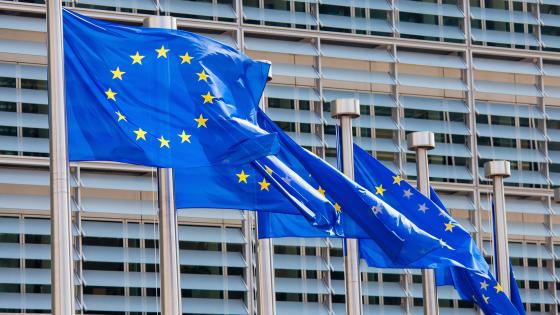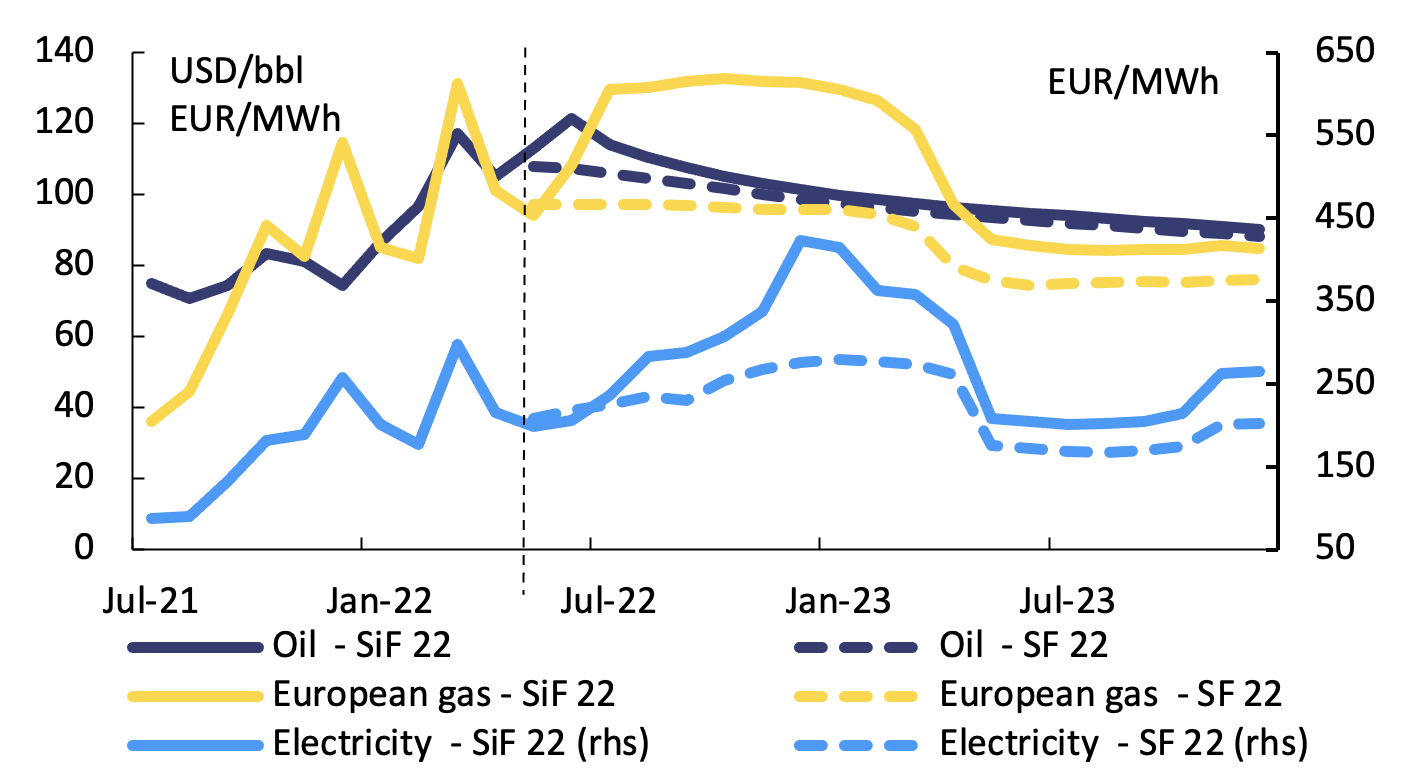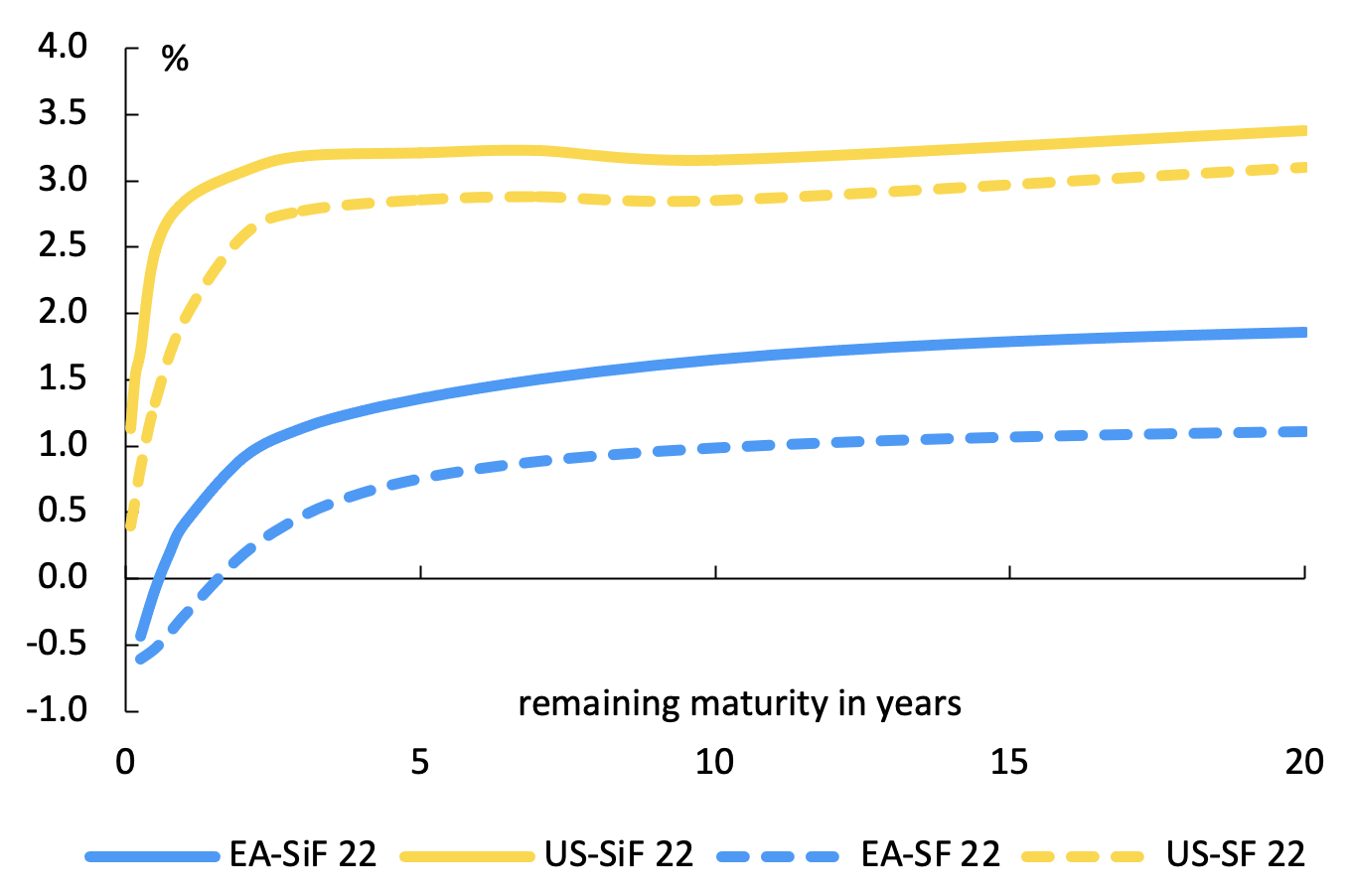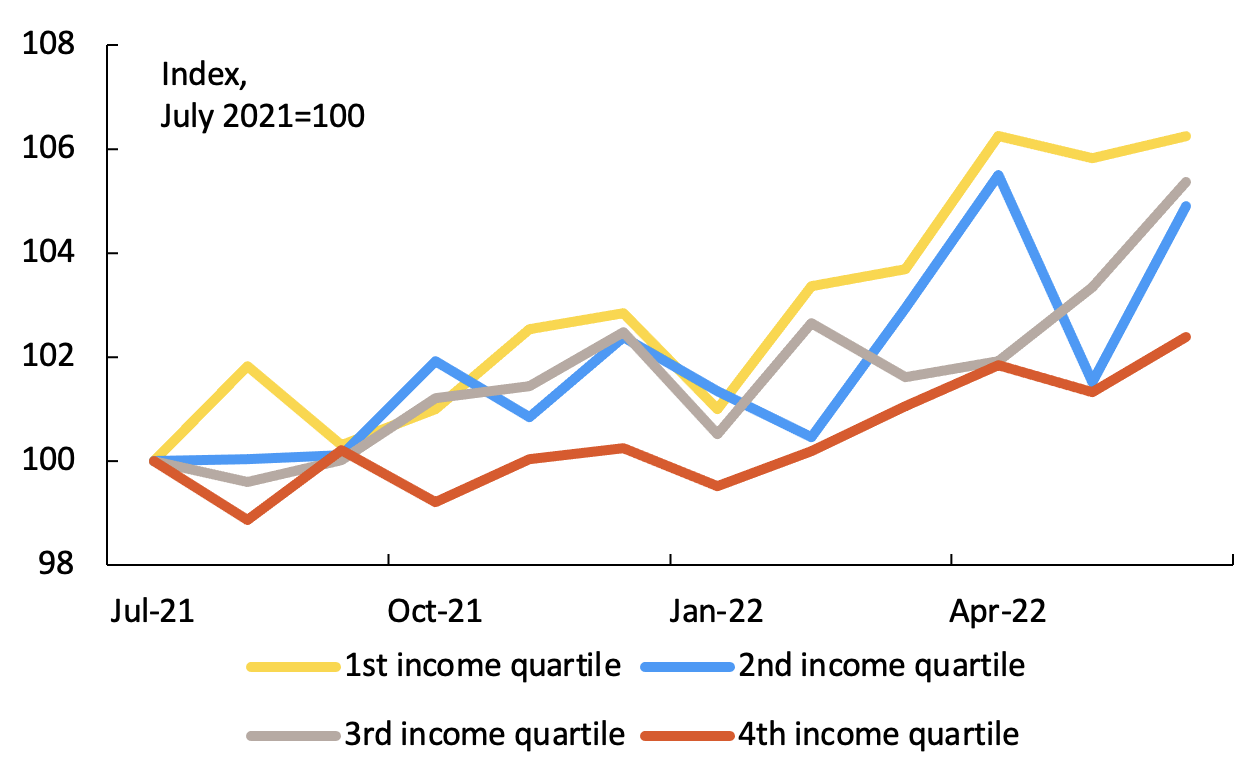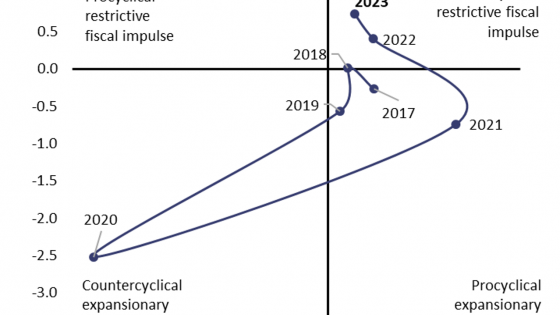The EU economy is being hit by several shocks…
Economic developments over the last two months force a profound reassessment of the EU’s growth and inflation outlook.
First, European gas spot and futures prices have moved up substantially over the past few weeks. This follows the cuts in the supply of gas from Russia and concerns about future deliveries (IEA 2022). Electricity price futures also rose, particularly for the winter seasons of both 2022 and 2023 (see Figure 1).
Figure 1 Energy commodity price assumptions
Note: The assumptions are based on 10-day moving averages of future prices. For wholesale electricity price assumtions, a weighted average of data from DE, FR, IT, ES, NL, BE and AT is used.
Source: ICE Futures Europe.
Second, as evidence of broadening price pressure grows, the ECB and other EU central banks are set to accelerate the unwinding of monetary support. Markets now expect short-term interest rates to increase more swiftly (see Figure 2). Long-term government bond yields have also increased. Tightening credit standards, a surge in corporate yields, and a large correction in equity valuations contribute to a less accommodative financial conditions.
Figure 2 Yield curves in the euro area and US
Note: Average par yield rates, average yields in the reference period of the forecast assumptions (17-30 June for SiF22 and 14-27 April for SF22).
Sources: ECB for Euro area, US Department of Treasury for US.
Third, global growth is weakening. Logistical and supply-chain disruptions continue to hamper global activity, though signs of easing are emerging. The damage from the strict COVID-related lockdowns implemented in China appears larger than previously expected, while the looming crisis of the Chinese property sector, a mainstay of growth during the past years, could have a long-lasting negative impact on the country’s growth prospects. US growth is also set to be weaker as the Fed is set to act forcefully to tame record inflation and a soft landing is increasingly called into question (Domash and Summers 2022). Real global GDP growth (excluding the EU) is now expected to grow by 3.0% in 2022 and 3.3% in 2023, 0.3 percentage points and 0.4 percentage points less, respectively, than in the European Commission’s Spring forecast (European Commission 2022a).
Finally, economic sentiment took a strong hit in the EU in the aftermath of Russia’s invasion of Ukraine, especially among consumers, whose confidence plummeted to levels close to the historical dip of April 2020, at the outset of the COVID-19 pandemic. The uptick in the euro area household saving rate recorded in the first quarter likely reflected not only the re-introduction of pandemic-related measures, which restricted consumption opportunities in the beginning of the quarter, but also an important fall in confidence.
…setting it on a path of lower growth…
These developments force a profound reassessment of the EU’s economic outlook. The European Commission’s Summer Interim Forecast (European Commission 2022b) expects that real GDP will grow this year by 2.7% in the EU and by 2.6% in the euro area (see Table 1).1 After a stronger than previously estimated first quarter of this year, economic activity is expected to have weakened in the second quarter, but should regain some traction during the summer thanks to a promising tourism season. In 2023, economic growth is expected to regain some momentum, on the back of a resilient labour market, moderating inflation, support from the Recovery and Resilience Facility (RRF), and a still large amount of excess savings. Yet, at 1.5% in the EU and 1.4% in the euro area, the projected growth rate for the year as a whole is well below the 2.3% expected in spring for both areas.
Table 1 Overview: The Summer 2022 Interim Forecast
…and higher inflation
Rapid price growth in recent months implies that annual inflation will remain elevated in 2022. Further external and domestic price pressures in the second half of the year are set to add to inflation carried over from its high readings until June. Inflation is now expected to peak at 8.9% in Q3 of 2022 in the EU (8.4%. in the euro area), one quarter later than in the Spring Forecast. HICP energy inflation is expected to drive the steady decline in headline inflation over the course of 2023. Food inflation is set to remain high in 2022, and to a lesser extent in 2023, reflecting the upward pressures currently at work along the entire food value chain. The lagged effects of the depreciation of the euro, high input costs, supply-side disruptions (including labour shortages), and rising wages are all set to keep feeding core inflation throughout 2023 – as the contribution of more volatile energy and food subsides. All in all, annual average inflation is projected at 7.6% in 2022 and 4.0% in 2023 in the euro area (and 8.3% and 4.6%, respectively, in the EU). Revisions to our previous inflation projections are considerable as inflation is expected to remain sustained in the first half of next year before decreasing sharply. By the end of the forecast horizon, headline inflation, at 2.5%, is still above the ECB target.
Lower income households are paying a high toll…
The increase in the level of prices between January 2021 and June 2022 has already raised the cost of households’ per capita consumption in the EU by around €160 per month, on average (see Box in European Commission 2022b). Households on lower incomes suffer the most from higher energy bills and food prices, as a larger share of their spending is on these basic items. On average in the EU, spending on food, electricity, and gas accounts for around 22% of total expenditure of the poorest quintile of households, compared to 15% for the highest-income quintile. Data from the EC consumer surveys (European Commission 2022c) reveal that consumers’ assessment of the past and expected financial situation of their household has been deteriorating for all income quartiles since July 2021, but the share of respondents assessing it has got, or will get, a lot worse is significantly higher among the lower income group (Figure 3). Similarly, the share of respondents reporting to be in financial distress – that is, having to draw on their savings or running into debt – is increasing across the board (Figure 4), but is reaching new highs among low-income households (European Commission 2022d).
Figure 3 Share of consumers in the EU reporting that the financial situation of their household got a lot worse over the last 12 months
Figure 4 Share of respondents in the EU reporting their household to be in financial distress
Member States have introduced a number of measures to dampen the impact of high energy prices on consumers (Sgaravatti et al. 2022). Most of these measures (around two thirds in terms of aggregate fiscal cost at EU level) can be classified as price policies, directly targeting the final energy price paid by households and firms. They include lowering indirect taxation (including excise duties on energy) or levies, subsidies, direct interventions in price setting, and social tariffs. These measures come at a high fiscal cost and, by reducing the price paid by consumers, they lower the incentive to reduce (fossil) energy consumption.
…warranting targeted support that can be sustained in the medium run…
As the reality of higher for longer energy prices sinks in, Member States should reassess the trade-offs between such price policies and income policies, in the form of compensation paid to energy consumers, through transfers in cash or in kind.
The benefits of such income policies are manifold (Bethuyne et al. 2022). By targeting vulnerable households, they support purchasing power where needed and without suppressing the price signal. This will keep intact the market incentives to households and businesses to transition to more energy-efficient technologies. Eventually, lower energy intensity leads to lower imports and improves the terms of trade. More targeted income policies would bring fiscal policies closer to the appropriate (broadly neutral) fiscal stance, thus facilitating debt reduction in Member States with high debt. The Eurogroup statement on fiscal policy orientations for 2023 (European Council 2022) encourages such policy adjustment.
Finally, a cacophony of different short-term price adjustments across Member States complicates the work of the ECB by increasing heterogeneity of price pressures within the euro area and by distorting energy inflation pass-through paths once price policies are implemented and eventually reversed.
… without interfering with efforts to accelerate energy transition
At the EU level, these policies are complemented by policy efforts aimed at frontloading the energy transition. The REPowerEU, in particular, sets out a number of measures aimed at saving energy, diversifying energy supplies, and boosting renewables. The Commission proposed to put the RRF at the heart of the REPowerEU Plan implementation, providing additional EU funding. Under the Commission’s REPowerEU proposal, Member States would be able to add a REPowerEU chapter to their Recovery and Resilience Plans to channel investments to REPowerEU priorities and make the necessary reforms. Funding to this end would come from the remaining RRF loans (currently €225 billion), voluntary transfers from common agricultural policy and cohesion policy funds (up to €53 billion), and new RRF grants funded by the auctioning of EU Emissions Trading System allowances, currently held in the Market Stability Reserve, worth €20 billion.
Ultimately, the only way to reduce the macroeconomic vulnerability stemming from the current high energy dependency is by accelerating the decarbonisation of the EU economy.
References
Bethuyne, G, A Cima, B Döhring, Å Johannesson Lindén, R Kasdorp, J Varga (2022), “Targeted income support is the most social and climate-friendly measure for mitigating the impact of high energy prices”, VoxEU.org, 6 June.
European Commission (2022a), "Russian invasion tests EU economic resilience", European Economy Institutional Paper 173, May.
European Commission (2022b), "Russia’s war worsens the outlook", European Economy Institutional Paper 183, July.
European Commission (2022c), "Business and consumer survey results for June 2022", DG ECFIN, June.
European Commission (2022d), "European business cycle indicators", Technical Paper 57, DG ECFIN, June.
European Council (2022), "Eurogroup statement on fiscal policy orientations for 2023", Eurogroup Statements and remarks, 11 July.
Domash, A and L Summers (2022), “Overheating conditions indicate high probability of a US recession”, VoxEU.org, 13 April.
International Energy Agency (2022), Gas Market Report, Q3-2022, July 2022.
Sgaravatti, G, S Tagliapietra and G Zachmann (2022), "National policies to shield consumers from rising energy prices", Bruegel dataset, 6 July.
Endnotes
1 The projected annual growth rate for this year is propped up by the momentum gathered with the recovery of last year and a somewhat stronger first quarter than previously estimated in the Spring Forecast.
